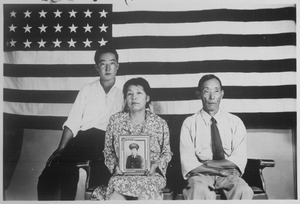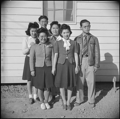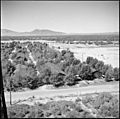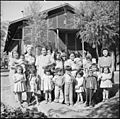Poston War Relocation Center facts for kids
Quick facts for kids
Poston Internment Camp
|
|
|---|---|
|
Detainee camp
|
|
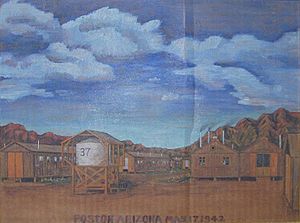
Painting of the Poston Internment Camp painted by Japanese American Tom Tanaka while interned
|
|
| Country | United States |
| State | Arizona |
| Opened | 1942 |
| Closed | 1945 |
| Founded by | War Relocation Authority |
| Population
(September, 1942)
|
|
| • Total | 17,814 |
The Poston Internment Camp was a large camp in Arizona, in the southwestern United States. It was one of ten camps where the U.S. government held people of Japanese descent during World War II. These camps were run by the War Relocation Authority.
The Poston camp was actually three separate camps, built about three miles apart. People living there called them Roasten, Toastin, and Dustin because of the hot desert weather. The Colorado River was close by, about three miles to the west.
Poston was built on land belonging to the Colorado River Indian Tribes. The Tribal Council did not want the camp there. They felt it was wrong to do to others what had been done to their own tribe. However, Army leaders and officials from the Bureau of Indian Affairs decided to build the camp anyway. They saw it as a chance to improve the land and farming on the Reservation.
At its busiest, over 17,000 people lived in the Poston camps. Most of them came from Southern California. At that time, Poston was the third largest "city" in Arizona. A builder named Del Webb constructed the camp. He later became famous for building retirement communities. The camp was named after Charles Debrille Poston, who helped set up the Colorado River Reservation in 1865.
A single fence went around all three camps. The area was so far away from other towns that guards did not think they needed to build watchtowers. Thousands of people lived inside this fenced area.
Contents
Why Was Poston Camp Built?
When Poston was chosen for the camp, the Colorado River Indian Reservation Tribal Council strongly said no. They did not want their land used to hold Japanese Americans, because they knew what it felt like to be treated unfairly. But their objections were ignored.
The Bureau of Indian Affairs (BIA) and the War Relocation Authority (WRA) took control of about 71,000 acres of tribal land. They started building in early 1942. Del Webb's company began building Poston I on March 27. His team of 5,000 workers finished the first camp in less than three weeks. Construction on Camps II and III started soon after.
Poston opened partly on May 8, 1942, as the Parker Dam Reception Center. This was one of two places that helped the 15 temporary "assembly centers." Japanese Americans waited in these centers before being moved to the more permanent WRA camps. About two-thirds of Poston's population came directly from their homes to Parker Dam. Many of these early arrivals helped finish building the camps.
Once completed, the Poston site had hundreds of living barracks, a hospital, offices, and housing for guards and staff. The camp officially opened as the Colorado River Relocation Center on June 1, 1942. The BIA handed over its control of Poston in 1943.
What Was Life Like at Poston?
Life at Poston was hard for the Japanese Americans from the very beginning. They had been forced to leave their homes and lives on the West Coast. The camps were built quickly, and there were not enough supplies. This made living conditions very difficult.
The barracks, or living quarters, were made of redwood. This wood shrank more than expected, creating cracks in the buildings. There was also a shortage of wood, so some buildings were made using adobe (a type of mud brick).
The desert weather also made life tough. Summers were extremely hot, reaching up to 115 degrees Fahrenheit. Winters were very cold, dropping as low as 35 degrees Fahrenheit. These extreme temperatures added to the frustration of the people living there.
Sickness was also a problem in most camps, and Poston was no different. There were 140 reported cases of tuberculosis, a serious lung disease. Care for the sick was not good. By the end of 1942, many barracks still did not have heating systems. People also had not received their clothing allowances.
All these problems caused a lot of anger and frustration among the Japanese Americans.
Rising Tensions and a Strike
The frustration of the Japanese Americans in Poston grew. Tensions became very high in November 1942. Workers went on strike on November 19. They were protesting the difficult conditions and unfair treatment. The camp director and the residents' Emergency Executive Council worked together. They reached an agreement, and the strike ended on November 24.
Unlike the other nine camps, Poston's farming and animal areas were inside the main fence. The people living in the camp built schools and other buildings. Many residents took part in activities like the Boy Scouts and sports teams. Baseball was very popular, and leagues were set up soon after the camp opened. Scores and game summaries were printed in the Poston daily newspaper. While there were some things that made life bearable, the time at Poston was mostly filled with struggles.
Stories and Books from Poston
A camp newspaper called Poston Chronicle was published from May 1942 to October 1945. It shared news and information with the residents.
Clara Breed, a librarian from San Diego, stayed in touch with children she knew who were sent to Poston. She wrote letters to them and sent them books and gifts. Their letters back to her became an important record of what life was like in the camps. Many of these "Dear Miss Breed" letters are now kept at the Japanese American National Museum. They were used for a 2006 book called Dear Miss Breed: True Stories of the Japanese American Incarceration during World War II and a Librarian Who Made a Difference.
A novel by Cynthia Kadohata, Weedflower, tells the story of a Japanese American girl and her family. It describes their life after the Attack on Pearl Harbor, when they were sent to Poston. The book is fiction, but it includes facts from interviews with people who lived in the camp and Mohave Indians from the reservation. The story shows how a young girl finds friendship and understanding during a difficult time.
Kiyo's Story, A Japanese American Family's Quest for the American Dream by Kiyo Sato is a memoir. It shares her family's experiences at the Poston camp during World War II. The book shows how family, love, and hard work helped them get through the huge losses they faced.
Passing Poston: An American Story is a documentary film. It shares the experiences of four Japanese Americans who lived in Poston. They are Kiyo Sato, Ruth Okimoto, Mary Higashi, and Leon Uyeda. Their stories show different sides of life in the camp. Ruth Okimoto remembers soldiers with rifles taking her family to Poston. Mary Higashi talks about how the camp affected her life and education. Leon Uyeda even says he somewhat enjoyed the camp because he was surrounded by other Japanese people and felt less racism.
The Japanese American Memorial to Patriotism During World War II in Washington, D.C., lists the names of those held at Poston. A short video called "Poston: A Cycle of Fear" also shows life at the camp.
Catherine Embree Harris, a teacher at Poston Camp 1, wrote a memoir called "dusty exile." It includes photos and stories about life in the camp until it closed.
A poem called That Damned Fence was written by someone held at Poston. It describes the feelings of being trapped and unfairly punished:
They've sunk the posts deep into the ground
They've strung out wires all the way around.
With machine gun nests just over there
And sentries and soldiers everywhere.
We're trapped like rats in a wired cage,
To fret and fume with impotent rage;
Yonder whispers the lure of the night,
But that DAMNED FENCE assails our sight.
We seek the softness of the midnight air,
But that DAMNED FENCE in the floodlight glare
Awakens unrest in our nocturnal quest,
And mockingly laughs with vicious jest.
With nowhere to go and nothing to do,
We feel terrible, lonesome, and blue:
That DAMNED FENCE is driving us crazy,
Destroying our youth and making us lazy.
Imprisoned in here for a long, long time,
We know we're punished—though we've committed no crime,
Our thoughts are gloomy and enthusiasm damp,
To be locked up in a concentration camp.
Loyalty we know, and patriotism we feel,
To sacrifice our utmost was our ideal,
To fight for our country, and die, perhaps;
But we're here because we happen to be Japs.
We all love life, and our country best,
Our misfortune to be here in the west,
To keep us penned behind that DAMNED FENCE,
Is someone's notion of NATIONAL DEFENSE!
What is Poston Like Today?
Some of the buildings built for the camps are still used today. Others are old and need repairs. Most of the buildings were removed after the camp closed. The land was given back to the Colorado River Indian Tribes. Many of the old buildings are now used for other purposes in nearby areas. The places where people lived are now mostly used for farming.
The Poston Memorial Monument was built in 1992. It stands on tribal land with the support of the tribe. It helps people remember what happened there.
Notable People Held at Poston
Many people who were held at Poston later became famous or important. Here are a few:
- Jack Fujimoto (born 1928), the first Asian-American to become president of a college in the mainland United States.
- Tak Fujimoto (born 1939), a cinematographer (someone who works with cameras for movies).
- Frances Hashimoto (1943–2012), a businesswoman and community leader.
- Satoshi Hirayama (1931–2021), a Japanese-American baseball player.
- Yosh Kawano (1921–2018), a clubhouse manager for the Chicago Cubs baseball team.
- Doris Matsui (born 1944), a member of the U.S. House of Representatives (a politician).
- Vincent Okamoto (1943–2020), a decorated veteran of the Vietnam War and a judge.
- Emiko Omori (born 1940), a cinematographer and director.
- Sandra Sakata (1940–1997), a fashion designer.
- Ben Sakoguchi (born 1938), an artist.
- Noriko Sawada (1923–2003), a writer and civil rights activist.
- Teru Shimada (1905–1988), an actor.
- A. Wallace Tashima (born 1934), the first Japanese-American to be appointed to a United States Court of Appeals (a high-level judge).
- Hisaye Yamamoto (1921–2011), a short-story writer.
Images for kids
-
Lieutenant Commander Ralph B. Snavely of the United States Public Health Service managing the construction of a well on April 9, 1942.
-
Apaches unloading bed frames for Japanese internees on April 29, 1942.
-
Hopi Indians at the Poston Center in September 1945.




